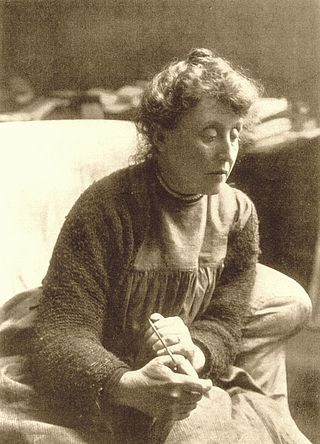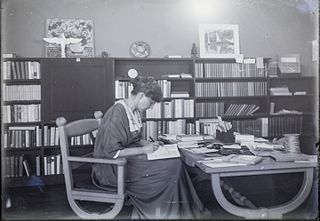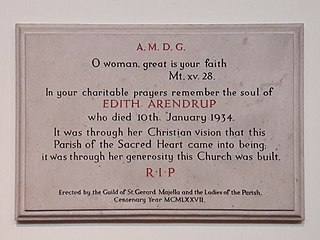Related Research Articles

The Women's Royal Naval Service was the women's branch of the United Kingdom's Royal Navy. First formed in 1917 for the First World War, it was disbanded in 1919, then revived in 1939 at the beginning of the Second World War, remaining active until integrated into the Royal Navy in 1993. WRNS included cooks, clerks, wireless telegraphists, radar plotters, weapons analysts, range assessors, electricians and air mechanics.

Elizabeth Amy Dillwyn was a Welsh novelist, businesswoman, and social benefactor. She was one of the first female industrialists in Britain.

Evelyn De Morgan was an English painter associated early in her career with the later phase of the Pre-Raphaelite Movement, and working in a range of styles including Aestheticism and Symbolism. Her paintings are figural, foregrounding the female body through the use of spiritual, mythological, and allegorical themes. They rely on a range of metaphors to express what several scholars have identified as spiritualist and feminist content. Her later works also dealt with the themes of war from a pacifist perspective, engaging with conflicts such as the Second Boer War and World War I.
Queenie Dorothy Leavis was an English literary critic and essayist.

The Voluntary Aid Detachment (VAD) was a voluntary unit of civilians providing nursing care for military personnel in the United Kingdom and various other countries in the British Empire. The most important periods of operation for these units were during World War I and World War II. Although VADs were intimately bound up in the war effort, they were not military nurses, as they were not under the control of the military, unlike the Queen Alexandra's Royal Army Nursing Corps, the Princess Mary's Royal Air Force Nursing Service, and the Queen Alexandra's Royal Naval Nursing Service. The VAD nurses worked in field hospitals, i.e., close to the battlefield, and in longer-term places of recuperation back in Britain.

Edward Henry Molyneux was a leading British fashion designer whose salon in Paris was in operation from 1919 until 1950. He was characterised as a modernist designer who played with the refinements of couture style, a modernist aesthetic, and the desire to be socially and culturally advanced.

Moelona was the pen-name of Elizabeth (Lizzie) Mary Jones, a Welsh novelist and translator who wrote novels for children and other works in Welsh.

Dame Edith Sophy Lyttelton was a British novelist, playwright, World War I-era activist and spiritualist.
Sally Roberts Jones is an English-born Welsh poet, publisher and critic.

The Golden Stairs is one of the best-known paintings by the Pre-Raphaelite artist Edward Burne-Jones. It began in 1876 and was exhibited at the Grosvenor Gallery in 1880.

Madge Jenison (1874–1960) was an American author, activist, and bookstore owner. She wrote novels, short stories, cultural criticism, and scripts. Her father, Edward Spencer Jenison, was a prominent Chicago architect who helped rebuild the city after The Great Chicago Fire of 1871. Her sister, Nancy Blanche Jenison, was a pioneering woman physician.

Edith Bulwer-Lytton, Countess of Lytton, was a British aristocrat. As the wife of Robert Bulwer-Lytton, 1st Earl of Lytton, she was vicereine of India. After his death, she was a court-attendant of Queen Victoria. Her children included suffragette Constance Bulwer-Lytton.

Edith Mary Arendrup, née Courtauld was an English artist and religious sister.
Ada Elizabeth Edith Swanwick RA (1915–1989), always known as Betty Swanwick, was an English artist, novelist and art teacher. She was head of illustration at Goldsmiths College and is known for her work for London Transport and an album cover for Genesis.
Edith Lucile Howard (1885–1959) was an American landscape artist. She was born in Bellow Falls, Vermont, and died of cancer in Moorestown, New Jersey, in 1959.
Mary Anderson Grierson was a Welsh-born Scottish botanical artist and illustrator. The youngest of three children to parents hailing from Dumfries, she was encouraged by her mother to paint from an early age but preferred watercolour over oil. Grierson served in the Women's Auxiliary Air Force as a flight officer in a photographic reconnaissance unit and used the skills she learnt into use later in her life. She joined De Havilland's public relations department after demobilisation and moved to Hunting Aerosurveys in 1947. Grierson was sent on a week course in pen and ink drawing in Suffolk ten years later and returned there for another ten years after finding the experience fulfilling.
Edith Branson (1891–1976) was an American painter who was known for her use of color to convey emotions. Her mature work included stylized figures and natural subjects as well as complete abstractions. She was intensely committed to her craft but made little effort to show in commercial galleries or sell her paintings by other means. Although her work appeared mostly in extremely large group exhibitions, it was nonetheless frequently singled out for comment in the local press.
Marjory Helen Petts née Miller (1921–2003) was a British artist and writer who, although born in London, spent the majority of her career in Wales.
References
- ↑ Who was who among English and European authors, 1931-1949: based on entries which first appeared in The Author's & writer's who's who & reference guide originally compiled by Edward Martell and L. G. Pine and in Who's who among living authors of older nations, originally compiled by Alberta Lawrence. Gale Research Co. 1978. ISBN 9780810300408.
- 1 2 3 4 "Nepean (née Bellis), Mary Edith". Dictionary of Welsh Biography. Retrieved 8 April 2016.
- ↑ "Molyneux Edward Nepean". Ancestry. Retrieved 8 April 2016.
- ↑ Retrieved 5 August 2018.